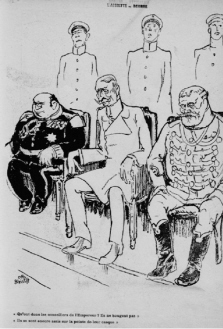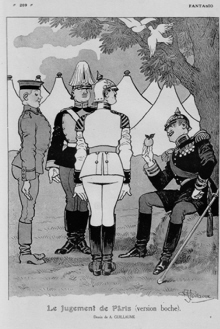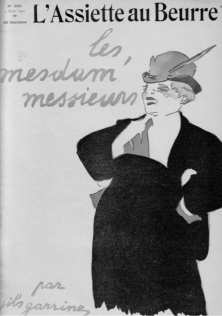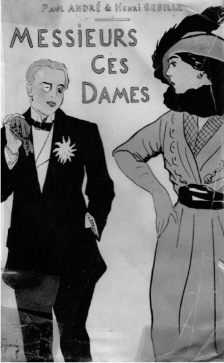The Dictionary of Homophobia (27 page)
Political Affairs
The international political affairs of the early twentieth century inspired a great number of homophobic caricatures, especially the events concerning Emperor William II of Prussia. In France, the desire for revenge (after Prussia’s annexation of Alsace and Lorraine during the Franco-Prussian War) appears to demasculinize the enemy, while at the same time Prussia’s imperial behaviour was denounced throughout France and Europe. The intention of critics was to mock the scientific militancy of Magnus
Hirschfeld
’s German homosexual movement, as well as a German
army
which had been shaken by sensational trials. As early as 1907, French writer and journalist John Grand-Carteret assembled more than 150 such caricatures in a single collection, published by E. Bernard in Paris.

L ’Assiette au beurre
, (December 2, 1911):
“What’s up with the Emperor’s advisors? They’re not doing anything.”
“They’re sitting on the points of their helmets.”
The magazine
L’Assiette au beurre
dedicated no less than two issues to these same subjects, whose content linked Prussia to acts of sodomy and prostitution. Paradoxically, in these caricatures, homosexuality is depicted to suggest not only the officer’s abuse of authority over his soldiers, but his to pacifism and anti-militarism (i.e. his weakness) as well.
The cover illustration by Jean Villemot, of the November 16, 1907, issue of
L’Assiette au beurre
, made reference to a man’s ancestral fear of submissive sodomy … but not just any man! Depicted was none other than Emperor William II seated on his throne, thinking to himself: “
My word! I can barely bring myself to stand up!
” Many other caricatures conjure up the image of the German nation completely overtaken by this
contagion
, from the Emperor to his ministers and high-ranking officers all the way down to soldiers.
L’Assiette
approached the subject again in the June 20, 1908, issue, entitled
Harden-Party
, chronicling the ups and downs of the military trials in Germany regarding accusations of homosexual conduct by prominent members of William II’s cabinet. The distinctive shape of German helmets took on a particular meaning, as illustrated by
L’Assiette
on December 2, 1911: “
What’s up with the Emperor’s advisors? They’re not doing anything
.
They are sitting on the points of their helmets
.
”
During World War I, the magazine
Fantasio
did not hesitate to keep up the tradition of depicting homosexuality, instead publishing a drawing by A. Guillaume,
Le Jugement de Paris (version boche)
(Judgment of Paris [Kraut version]), wherein a young, not-so-masculine soldier, accompanied by two junior officers, reports to a superior proffering an apple.

Fantasia
: “The Judgment of Paris (Kraut version)”
In France, the suggestion of homosexuality was never used as an attack against the government; homosexuality was considered a private affair, reserved for black masses or the “
ballets bleus
.” At the same time, the emasculation of politicians was regularly depicted, usually by way of cross-dressing: Joseph Reinach, best known as a champion of Alfred Dreyfus, was drawn wearing a wedding gown held by two clergymen in the May 28, 1898 issue of
Le Rire
, 1898; Leon Blum was often portrayed dressed in women’s clothes; a photographic montage depicted Jean Jaurès in women’s shoes holding in his hands the head of Aristide Briand (June 1, 1907, issue of
Fantasio
) and the War Minister, General Picquart, was also shown dressed in women’s clothes, all the while being severely reprimanded as he tightens his corset (drawing by A. Barrère, November 15, 1906, issue of
Fantasio
).

L’Assiette au beurre
: “
Mesdam’ messieurs
”
Civil Affairs
In France, caricatures typically targeted the supposed
decadence
of the subjects they depicted. This decadence was largely considered to be the province of those born of affluence (Adelswärd-Fersen), or a luxury enjoyed by the “fine-mannered” bourgeoisie. The clash of the sexes and genders combined with the battle of the classes in these sometimes stinging, sometimes simply amusing drawings. The decadence of the
Belle Epoque
(“Beautiful Era,” pre-World War I) was often tied to the image of the effeminate boy or with infantilism, while the sporty fashion of the waif of the
Années folles
(“Mad Years,” post-World War I) played on the masculinization of women. Many different expressions became popular to describe homosexual men and women:
ces messieurs-dames
(“these gentlemen-ladies”),
les p’tits jeun’hommes
(“young l’il boys”), and
mesdames-messieurs
(“lady gentlemen”). “The third sex” or “third gender” were also common phrases, along with various epithets (terrible, queer, …); all were expressions that permitted many effective plays on words in French.
Dedicated entirely to the
p’tits jeun’hommes
, issue 422 of
L’Assiette au beurre
(1909) is an extraordinary volume. In only a few pages, it references a good number of turn-of-the-century negative archetypes; throughout, the image of the
p’tit jeun’homme
is mocked for his outrageous makeup and flamboyant style of dress. The cover illustration depicts a young boy with blond hair, holding a finger to his brightly painted red lips. With a large flower in his lapel, rings on his fingers, a cravat, and a rakish stance, he is out to seduce by any means possible—he make his historical references (
“Plato was one
…
Socrates too”
), and is shown to be in direct competition with women, in whom he does not see any erotic use (
“Wouldn’t you say that the greatest achievement of our time will be that women will be no longer necessary for love?”
). On the other hand, a certain complicity is implied between these depictions—after all, what does one’s sex matter if the “gender” is the same? In this vein, the July 15, 1924, issue of
Fantasio
was presented under the title of “Daily Affairs,”
l’éphèbe et la garçonne (presque une fable)—“the ephebe and the waif (practically a fairy tale)”—
featuring an illustration of a young man and a young woman seated together at the same table, practically the mirror image of the each other.
Les gâcheuses
(The wastefuls) was the subject and the title of a special August 1923 issue of the magazine
La Charrette “Charrie”
(issue 21). “
Les gâcheuses
” was a rarely-used expression, containing two reproaches against the choice of a homosexual lifestyle—physiological
sterility
, and the waste of both bodily fluids and affection, implying that both stem from a lack of judgment. The concept of the “loss of seed,” as Emile Zola called it in his preface to Dr Laupts’
Invertis et homosexuals
, is clearly illustrated in a symbol-laden drawing entitled
Tendresse ancillaire
(Ancillary affection)—“You must pay more attention, my love! You have once again let the milk burn,” declares a gentleman in a pink jacket with a flower on the lapel to his “butler.”
Perversion
creates confusion when categorizing places of leisure; for example, the cover illustration shows a short-haired woman dressed in a smoking jacket and tie, looking perplexed as she stands in front of the “Men’s” sign outside the toilets. This confusion leads to waste: affection becomes the sentimentality of effeminate males and transvestites striving toward hyperbole in order to cover up their miserable and ridiculous condition. A dispute becomes a
Drame passionnel
(Drama of passion); the “women” take up sewing or needlepoint to forget about the problems at home, or become wallflowers at balls because they’re too old or too ugly. Separation becomes a fetishist drama in
Lorsque tout est fini
(After it’s all over). And in
Relique d’amour
(Relic of love), an old man sitting on a bench stares nostalgically at the picture on the wall of a boy in suspenders.

L’Assiette
au beurre
: “
Messieurs Ces Dames
”
The French literary world, too, was not safe from accusations of promoting
inversion
, as shown by its many representations of male homosexuality in educated circles (a French trait, it would seem). The illustrator Camara mocked writer Jean Lorrain’s academic aspirations with a ring-bedecked appearance on the March 7, 1903, cover of
L’Assiette au beurre
. Baron Adelswärd-Fersen, whose trial for offenses of indecency was constantly in the news, found himself the subject of a July 26/August 1, 1903, special edition of
Canard sauvage
, entitled “Black masses.” The emphasis in this instance was placed on the “abominable” habits of an aristocracy, who considered heterosexuality the province of a rabble who just did not understand poetry. The writer Maurice Rostand, too, was persecuted throughout the length of his career: sketched in the February 15, 1922, issue of
Fantasio
as “Chanteclarinet” (an allusion to Chantecleer, a successful work of his father’s), and depicted in
Le Sourire du jeudi
of May 25, 1933, as a naked woman, with the caption
Soyez les bien vu nus
(“good to see you naked”; “
bien vu nu
” is a phonetic pun on the word for welcome, “
bienvenue
”). In a April 25, 1903, special edition of
L’Assiette au beurre
dedicated to the “Esthetics,” Paul Iribe confirmed dandyesque poet Robert de Montesquiou’s reputation on the cover page, with the following page of writer Pierre Loti (who had recently published
Mon frère Yves
)—in which a woman berates a distinguished-looking man holding a book entitled
Mon frère IV
, by Pierlo To, saying, “Come now, my dear—you don’t have the excuse of being a sailor!” Also in the same issue: “You’re coming to supper, right? We’re having Pierre Loti and his new brother Yves…,” implying homosexual activity.
Women, too, were not safe from these illustrators (all men), although they benefited from a different sort of treatment. While the feminization of a man was considered an insult, the masculinization of a woman was a badge of honor, especially during a time of growing feminism. More so than the effeminate male, it seems the lesbian was the paragon of female independence.